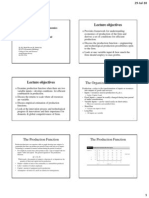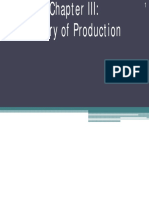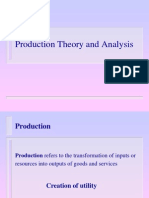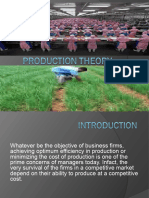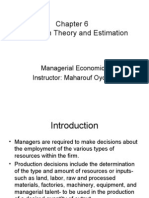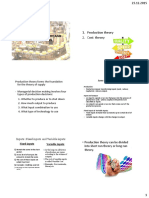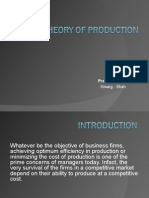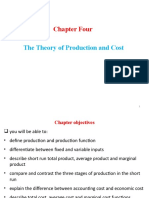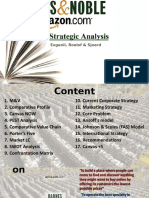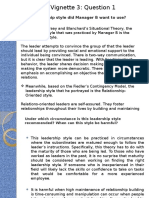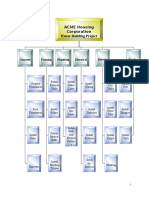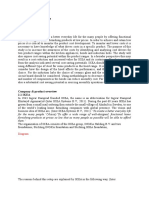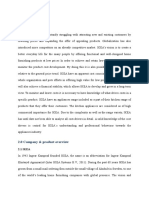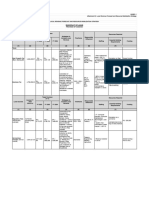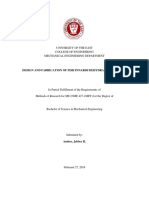10/6/2013
Lecture objectives
BEEG5013 Managerial Economics
o Provides framework for understanding
economics of production of the firm and
derives a set of conditions for efficient
production.
o Discuss the production function engineering
and technological production possibilities open
to the firm.
o Look at one variable input & how much the
firm should employ to max profits.
Chapter 6: Production Theory and
Estimation
Dr. Hj. Mohd Razani Hj. Mohd Jali
Room 0.55 Economics Building
School of Economics, Finance and Banking
College of Business
razani@uum.edu.my
04-928 3524
Lecture objectives
The Organization of Production
o Examine production function when there are two
variable inputs develop conditions for efficient
combination in production.
o Discuss the returns to scale where all resources
are variable.
o Discuss empirical estimation of production
functions.
o Look at the innovation process and technological
progress & innovations and their importance for
domestic & global competitiveness of firms.
Production refers to the transformation of inputs or resources
into outputs of goods and services.
Inputs resources used in production of g & s.
Labor, Capital, Land
Fixed Inputs cannot be readily changed during time period
of under consideration.
Variable Inputs can be varied easily on short notice.
Most raw materials and unskilled labor.
Short Run
At least one input is fixed
Long Run
All inputs are variable
3
The Production Function
The Production Function
Production function is an equation, table or graph showing max output of a
commodity that firm can produce per period of time with each set of inputs.
Technology is assumed to remain constant during the period of analysis.
For simplicity assume that a firm produces only 1 type of output with two
inputs labor and capital. The general equation of the production
function:
Q = f (L, K)
Which reads the quantity of output is a function of, or depends on, the
quantity of labor and capital used in production.
Output number of units of the commodity (i.e automobiles) produced.
Labor number of workers employed.
Capital amount of equipment used in production.
Assumption all units of L and K are identical or homogeneous.
�10/6/2013
Production Function with One Variable Input
Production Function with One Variable Input
Total product (TP) holding the quantity of one input constant
and changing quantity used of other input, we can derive the
TP of the variable input.
Marginal product (MP) of labor (MPL) is change in total
product of extra output per unit change in labor used.
Average product (AP) of labor (APL) equals total product
divided by the quantity of labor used.
Output elasticity of labor (EL) measures % change in output
divided by % change in quantity of labor used.
Total Product
TP = Q = f(L)
Marginal Product
MPL =
TP
L
Average Product
APL =
TP
L
Production or
Output Elasticity
EL =
MPL
APL
10
11
12
�10/6/2013
The law of diminishing returns and stages of
production
Law of diminishing returns as we use more and more units
of variable input with a given amount of the fixed input, af ter
a point, we get diminishing returns (marginal product) from
the variable input.
This is not a theorem but a physical law which has been found
to be always empirically true.
Each additonal unit of variable input has less and less of fixed
input to work with and, after a point, MP of the variable input
declines.
13
The law of diminishing returns and stages of production
Relationship between MPL and APL curves (bottom panel of
Fig 6-4) shows three stages of production for labor
Stage I of production
Stage II of production
Stage III of production
Rational producer would not operate in stage III of labor, even
if labor time were free, because MPL is negative. Greater
output or TP could be produced using less labor.
Producer will not produce in stage I because this corresponds
to stage III of capital (MP of capital is negative).
Thus, rational producer will operate in stage II, where MP of
both factors is positive but declining.
14
Optimal use of the variable input
Marginal revenue product of labor (MRPL) the extra revenue
generated by use of an additional unit of labor. This equals
marginal product of labor (MPL) time marginal revenue (MR)
from sale of extra output produced.
MRPL = (MPL)(MR)
Marginal resource cost of labor (MRCL) the extra cost of
hiring an additional unit of labor. This equals to the increase
in the total cost to the firm resulting from hiring additional unit
of labor.
TC
MRCL =
L
15
16
17
18
The firm should continue to hire labor as long as MRP L >
MRCL and until MRPL = MRCL.
�10/6/2013
Production with Two Variable Inputs
Isoquants show combinations of two inputs that can produce
the same level of output.
19
20
21
22
Firms will only use combinations of two inputs that
are in the economic region of production, which is
defined by the portion of each isoquant that is
negatively sloped.
Negatively slopped portion of the isoquants within
the ridge lines represents the relevant economic
region of production. This refers to stage II of
production for labor and capital, where MP L and MPK
are both positive but declining.
Producers will never want to operate outside this
region.
23
Marginal rate of technical substitution (MRTS) the absolute
value of the slope of the isoquant.
MRTS = -K/L = MPL/MPK
24
�10/6/2013
25
26
27
28
Returns to Scale
Returns to scale degree by which output changes as a result
of a given change in the quantity of all inputs used in
production. Three types of returns to scale (if quantity of input
increased in a given proportion):
Constant returns to scale output increases in the same
proportion.
Increasing returns to scale output increases by a greater
proportion.
Decreasing returns to scale output increases by a smaller
proportion.
29
30
�10/6/2013
Questions or comments?
Reference:
Salvatore (2008/2012), Ch. 6
31
32
